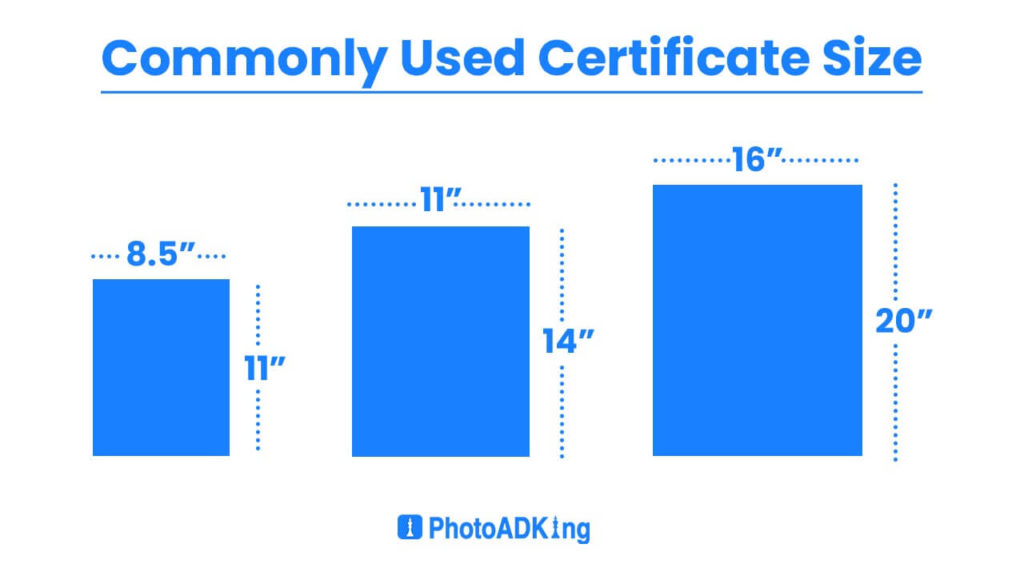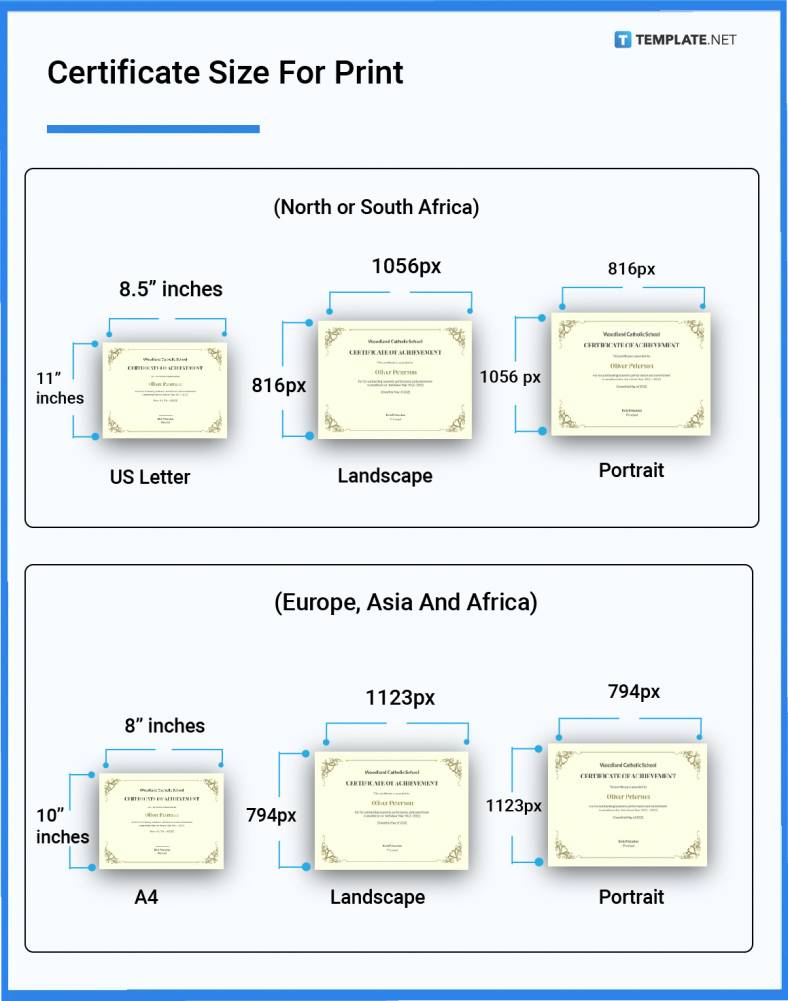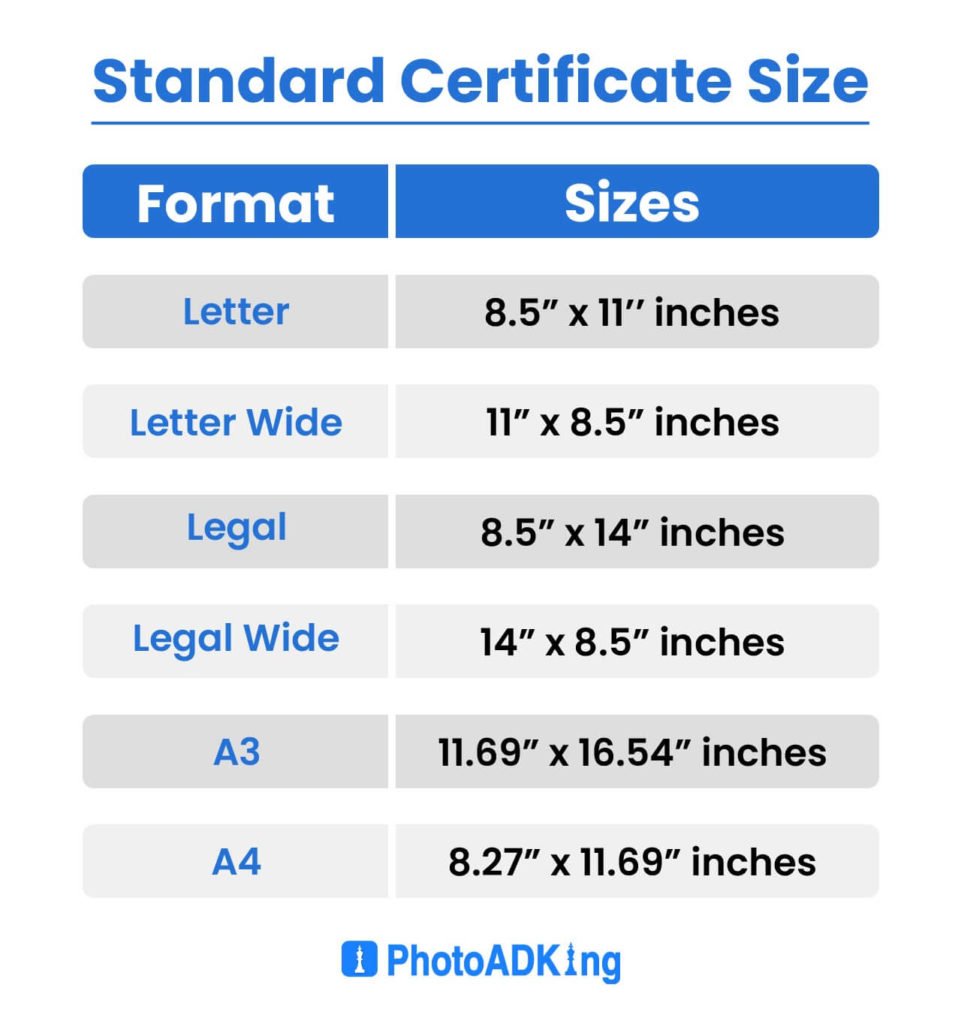Certificates come in various sizes and dimensions. Knowing the standard sizes can help in selecting the right one for your needs.
Certificates are used for awards, recognition, and achievements. They need to look professional and fit standard frames. The size of a certificate can make a big difference in its presentation. In this blog post, we will explore the most common certificate sizes and dimensions.
Understanding these standards will help you choose the best format for your certificates. Whether for academic awards, employee recognition, or personal achievements, getting the size right is essential. Let’s dive into the details of standard certificate sizes and dimensions.
Introduction To Certificate Sizes
Certificates are a key part of recognizing achievements. They mark important milestones in various fields. To maintain a professional look, it’s crucial to use standard certificate sizes. This ensures a neat, consistent presentation for all certificates.
Importance Of Standard Sizes
Standard sizes make certificates look uniform. They fit well in frames. This consistency helps in maintaining a professional appearance. It also makes printing and framing easier. Choosing a non-standard size can lead to problems. It might not fit standard frames or folders. This can result in additional costs and inconveniences.
Common Certificate Types
Certificates come in various types. Each type has a common standard size. The most popular size is 8.5 x 11 inches. This is the same size as standard letter paper. It is widely used for academic and professional certificates.
Another common size is 11 x 14 inches. This size is often used for diplomas and special awards. It provides a larger space for detailed designs and text.
Some certificates use the A4 size, which is 8.27 x 11.69 inches. This size is popular in many countries outside the United States. It is slightly different from the letter size but still fits most standard frames.

Standard Certificate Dimensions
Certificates are important documents that recognize achievements. They come in various sizes and dimensions. Knowing the standard sizes helps in designing and printing them correctly. This ensures they fit well in frames or folders.
Us Standard Sizes
In the United States, the most common certificate size is 8.5 x 11 inches. This size matches standard letter paper, making it easy to print. Another popular size is 11 x 14 inches. This larger size gives more space for elaborate designs.
International Standard Sizes
Internationally, A4 size is the most common for certificates. A4 dimensions are 210 x 297 millimeters or 8.27 x 11.69 inches. This size is widely used in many countries. Another standard size is A3, which is 297 x 420 millimeters or 11.69 x 16.54 inches. This size is perfect for larger certificates with more details.
Choosing The Right Size
Choosing the right size for a certificate is crucial. It ensures the document is both functional and visually appealing. The size affects how the certificate is used and how it is received. Let’s explore the factors to consider under the subheadings Purpose and Function and Audience and Presentation.
Purpose And Function
The purpose of the certificate determines its size. If it is for an award, it should be large enough to display details clearly. Common sizes for awards are 8.5 x 11 inches or 11 x 14 inches. These sizes allow space for text and logos.
For professional certifications, a standard size of 8.5 x 11 inches works well. It fits into standard document frames and folders. Use a smaller size, like 5 x 7 inches, for event participation certificates. This makes them easier to distribute and store. Consider the purpose carefully to choose the right size.
Audience And Presentation
Knowing your audience helps in selecting the size. For children, a smaller certificate like 5 x 7 inches is suitable. It is easy for them to handle and display. For adults, a larger size is more appropriate. It feels more significant and professional.
Presentation matters too. A larger certificate looks impressive in a frame. It stands out on a wall or desk. Ensure the size fits common frame sizes to make it easier for recipients to display their achievement.
Consider the following table for quick reference:
| Type | Recommended Size |
|---|---|
| Award | 8.5 x 11 inches or 11 x 14 inches |
| Professional Certification | 8.5 x 11 inches |
| Event Participation | 5 x 7 inches |
In summary, the right size depends on the purpose and audience. Make sure the certificate is practical and looks good when presented.
Custom Certificate Sizes
Standard certificate sizes are common, but sometimes you need a custom size. Custom certificate sizes allow you to create unique and personalized documents. This flexibility can make your certificate stand out. Let’s explore the benefits and design considerations of custom certificate sizes.
Benefits Of Custom Sizes
- Uniqueness: Custom sizes make your certificate distinctive.
- Fit for Purpose: Tailor the size to the content or recipient.
- Brand Alignment: Match your certificate size with your brand’s identity.
- Versatility: Use unique sizes for different types of awards.
Design Considerations
Designing custom certificates involves several key factors. First, consider the aspect ratio. A balanced aspect ratio ensures your certificate looks professional.
Next, think about the margins. Proper margins keep the content clear and uncluttered. Also, choose a font size that is readable but fits the custom dimensions.
Use a high-resolution template to maintain quality. Low-resolution designs can look pixelated when printed. This affects the overall appearance.
Finally, ensure your design aligns with your brand colors. Consistent colors reinforce your brand identity.
| Aspect Ratio | Recommended Use |
|---|---|
| 4:3 | Traditional certificates |
| 16:9 | Modern designs |
| Square | Creative awards |
Printing Techniques
Printing techniques play a crucial role in the quality of certificates. Choosing the right method ensures the final product looks professional and appealing. Two popular printing techniques are digital printing and offset printing. Each method has its unique advantages.
Digital Printing
Digital printing is a modern method. It uses digital files like PDFs. This technique is great for short runs and quick turnarounds. Digital printers use toner or liquid ink. The quality is high and colors are vibrant. Digital printing is cost-effective for small quantities. It allows for easy customization. Changes can be made without extra cost. This is perfect for personalized certificates.
Offset Printing
Offset printing is a traditional method. It uses plates to transfer images to paper. This technique is ideal for large runs. The initial setup is more complex. But the cost per unit decreases with volume. Offset printing delivers consistent high quality. The colors are sharp and precise. It is best for bulk printing of certificates. The process is more time-consuming. But the result is worth the wait.

Paper Types And Quality
Choosing the right paper type and quality is crucial for creating impressive certificates. The right paper can enhance the look, feel, and durability of a certificate. Let’s explore the different paper types and their qualities.
Recommended Paper Types
Not all paper types are suitable for certificates. Here are some recommended options:
| Paper Type | Description |
|---|---|
| Card Stock | Thicker and more durable than regular paper. Ideal for certificates. |
| Parchment Paper | Has a unique, antique appearance. Adds a touch of elegance. |
| Linen Paper | Textured surface. Feels luxurious and professional. |
Impact Of Paper Quality
The quality of paper affects the overall presentation of the certificate.
- Durability: Higher quality paper resists wear and tear better.
- Appearance: Premium paper enhances color and detail.
- Feel: A good quality paper feels more substantial and professional.
Using high-quality paper ensures your certificates look and feel their best. It makes a lasting impression on the recipient.
Consider investing in good paper for your certificates. It is worth the extra cost.
Design Tips For Perfect Prints
Designing certificates can seem challenging, but it doesn’t have to be. With the right tips, you can create perfect prints every time. These tips will help you choose the best color schemes and fonts. Your certificates will look professional and appealing.
Color Schemes
Selecting the right color scheme is crucial. It sets the tone for your certificate. Use colors that complement each other. Avoid using too many colors. Stick to a maximum of three. This ensures your certificate looks clean and polished.
Consider the purpose of the certificate. For formal occasions, use muted tones. For more casual events, brighter colors may be suitable. Always ensure the text is readable. Light text on a dark background works well. Dark text on a light background is also effective.
Font Choices
Choosing the right font is just as important as color. The font should be easy to read. Avoid overly decorative fonts. They can be hard to read, especially in small sizes. Stick to classic fonts like Arial or Times New Roman.
Use bold fonts for headings. This makes them stand out. For the body text, use regular or light fonts. Ensure there is a good contrast between the text and background. This helps with readability.
Mixing two fonts can add interest. But don’t use more than two. This keeps the design cohesive. Remember, simplicity is key. Your goal is a professional and clean look.
Framing And Display
Displaying a certificate with the right frame elevates its importance. Framing adds a professional touch and preserves the certificate. This section explores the best practices for framing and displaying certificates.
Frame Size Compatibility
Choosing the right frame size is crucial. Standard certificate sizes typically include:
- 8.5 x 11 inches
- 11 x 14 inches
- A4 (8.27 x 11.69 inches)
Ensure the frame matches the certificate dimensions. Use a frame that complements the certificate’s size. This avoids any gaps or overlaps.
If unsure of the certificate size, measure it before purchasing a frame. This ensures a perfect fit.
Display Techniques
Displaying certificates correctly enhances their visibility and importance. Here are some effective techniques:
- Wall Mounting: Use hooks or nails to hang the framed certificate. Choose a prominent spot, like an office wall.
- Tabletop Display: Use a stand or easel. Place the framed certificate on a desk or shelf.
- Gallery Wall: Create a gallery of framed certificates. Arrange them in a grid or creatively.
- Lighting: Use spotlights or LED lights. This highlights the certificate and makes it stand out.
These techniques ensure your certificates are displayed proudly and professionally.

Frequently Asked Questions
What Are Standard Certificate Sizes?
Standard certificate sizes are typically 8. 5 x 11 inches or A4. These dimensions are widely used for various types of certificates.
Can Certificates Be Customized?
Yes, certificates can be customized in size, design, and material. Customization helps make the certificate unique and special.
What Is The Common Paper Weight For Certificates?
Common paper weight for certificates is 100-200 gsm. This ensures durability and a premium feel.
Are Certificate Dimensions The Same Worldwide?
No, certificate dimensions can vary by region. In the US, 8. 5 x 11 inches is common, while A4 is used internationally.
Conclusion
Understanding standard certificate sizes and dimensions is important. It helps in creating professional documents. Consistency in size ensures compatibility with frames and holders. Whether for awards, diplomas, or recognitions, standardized sizes bring uniformity. This knowledge simplifies printing and presentation. It also saves time and resources.
Now, you can confidently design and print certificates. Keep these guidelines in mind for your next project. Happy designing!

